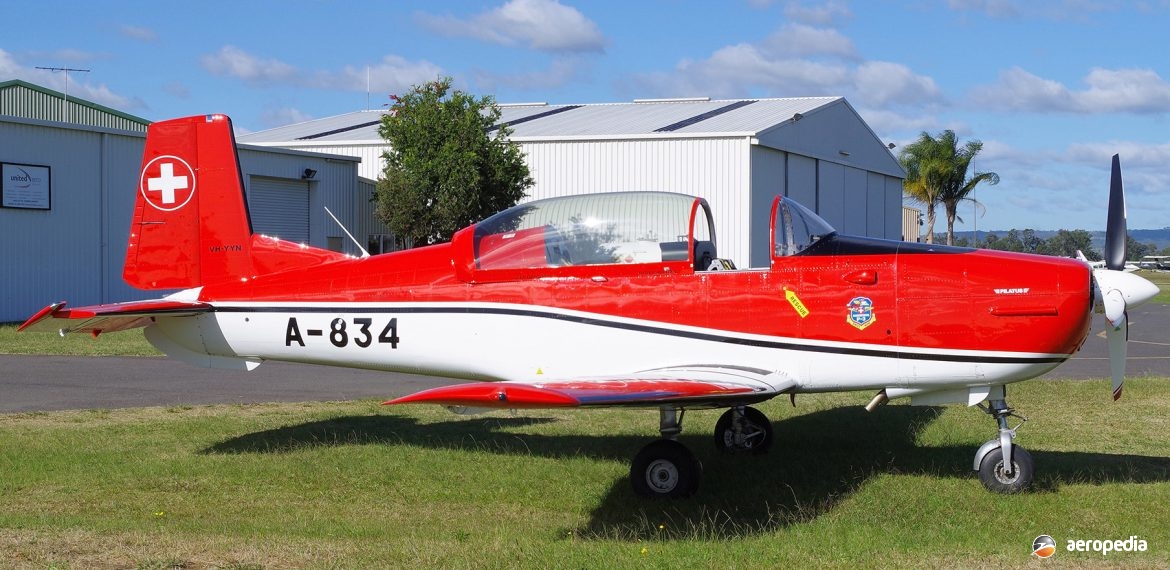Photograph:
Pilatus P-3 VH-YYN (c/n 478-21) at Camden, NSW in May 2015 (David C Eyre)
Country of origin:
Switzerland
Description:
Two-seat military training monoplane
Power Plant:
One 194 kw (260 hp) Lycoming GO-435-C2A six-cylinder horizontally-opposed air-cooled engine
Specifications:
- Wingspan: 10.39 m (34 ft 1 in)
- Length: 8.77 m (28 ft 8½ in)
- Height: 3.04 m (10 ft)
- Wing area: 16.44 m² (177 sq ft)
- Max speed at sea level: 309 km/h (192 mph)
- Max cruising speed: 275 km/h (170 mph)
- Economical cruising speed: 249 km/h (155 mph)
- Minimum speed: 100 km/h (62 mph)
- Initial rate of climb: 420 m/min (1,378 ft/min)
- Service ceiling: 5,499 m (18,040 ft)
- Absolute ceiling: 6,100 m (20,000 ft)
- Range at economic cruising speed: 750 km (466 miles)
- Endurance: 3 hours
- Fuel capacity: 319 litres (70.2 Imp gals)
- Take-off run over 15 m (50 ft) obstacle: 372 m (1,221 ft)
- Take-off run from grass: 430 m (1,290 ft)
- Landing distance over 15 m (50 ft) obstacle: 430 m (1,290 ft)
- Landing speed 114 km/h to 119 km/h: (71 to 74 mph)
- Empty weight: 1,048 kg (2,310 lb)
- Loaded weight: 1,497 kg (3,300 lb)
Armament:
One 7.9 mm (0.30 in) machine gun in pod under port wing and two Oerlikon 5 cm launchers for rockets, or four practice bombs
History:
Pilatus Flugzeugwerke based at Stans, Switzerland was established on 16 December 1939 to produce aircraft and one of its designs was the P-3 tandem two-seat trainer, the prototype HB-HON (model P-3-01) being first flown on 3 September 1953. This model replaced the P-2 and Bucker Bu 131 Jungmann in military service. The definitive prototype flew for the first time in August 1954. In January 1955 it was extensively tested and was chosen as the Swiss Air Force standard trainer in January 1956, when the first aircraft (A-801 – now preserved) was taken into service.
An initial batch of 12 aircraft was ordered, the next aircraft, the HB-HOO (model P-3-02) flying in August 1954, having full military instrumentation, blind flying equipment, a machine gun and gyro-gunsight, a camera gun and underwing pylons for rockets or training bombs. Initial testing was with a two-blade Hartzell propeller but this was replaced by a three blade variable-pitch constant speed Hartzell unit. Further aircraft in this batch were known as the P-3-03, followed by the P-3-04, and were placed on the civil register as HB-HOA, HB-HOB, HB-HOC, HB-HOD, HB-HOE and HB-HOG, with civilian instrumentation, civilian radios and IFR equipment. These aircraft were later sold to the Brazilian Navy.
The P-3 is a low-wing cantilever monoplane fitted with a Lycoming GO-435-C2A engine, the wing being a single-spar aluminium alloy structure carrying ailerons and electrically-actuated slotted flaps. The semi monocoque fuselage is of all metal. The cockpit is enclosed by a one-piece sliding canopy. Max permissible speed is 508 km/h (316 mph).
The P-3 was the primary basic trainer and was also used for armament training with a single 7.9 mm (0.30 in) machine gun in a pod under the port wing. Only exports of the type were six aircraft to the Brazilian Navy. One Swiss aircraft crashed out of a flat spin and following investigation all later aircraft were fitted with a ventral strake. Production concluded in 1959 after 80 had been completed, 14 being lost in Swiss service, being eventually replaced by the PC-7. The last operational aircraft were used as liaison aircraft by the air force, the last being retired in 1991. The survivors, comprising 78 aircraft, were sold to civilian owners from Lodrino / Einsatz in Switzerland in 1992 and are seen all over Europe at aviation events.
A number of P-3s survive around the world in Switzerland, the UK, France and the United States, with 45 flown privately as warbirds. One example in the United States was painted in USAF markings by Hall Aviation and fitted with a Walter turbine, this having a cruising speed of 435 km/h (270 mph). One example was imported to Australia in 2011 and, after being stored by Aerial Agriculture at Bankstown, NSW for a time, was placed on the civil aircraft register as VH-YYN (c/n 478-21 – ex A834) to Robert Sheehan of Camden, being based at Bathurst, NSW.

